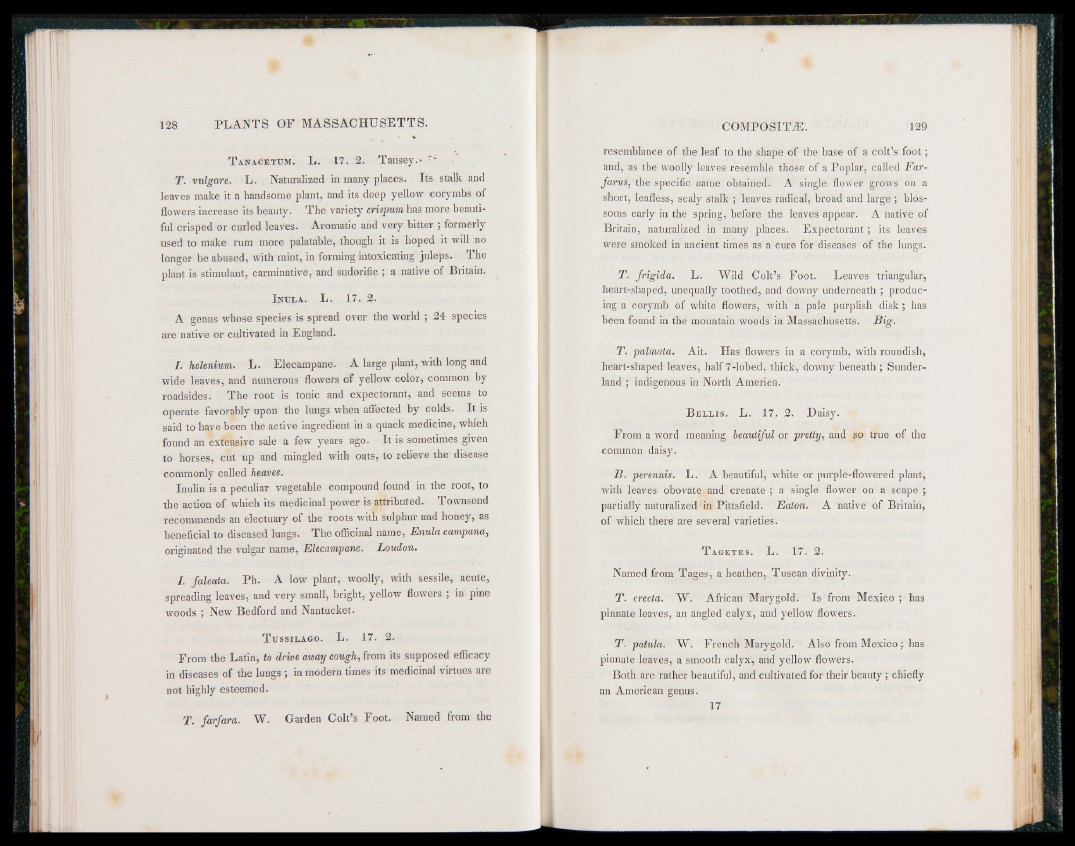
T anacetum. L. 17. 2. Tansey.* ?1-
T. vulgare. L . Naturalized in many places. Its stalk and
leaves make it a handsome plant, and its deep yellow corymbs of
flowers increase its beauty. The variety crispum has more beautiful
crisped or curled leaves. Aromatic and very bitter ; formerly
used to make rum more palatable, though it is hoped it will no
longer be abused, with mint, in forming intoxicating juleps. The
plant is stimulant, carminative, and sudorific ; a native of Britain.
I nula. L. 17. 2.
A genus whose species is spread over the world ; 24 species
are native or cultivated in England.
I. helenium. L. Elecampane. A large plant, with long and
wide leaves, and numerous flowers of yellow color, common by
roadsides. The root is tonic and expectorant, and seems to
operate favorably upon the lungs when affected by colds. It is
said to have been the active ingredient in a quack medicine, which
found an extensive sale a few years ago. It is sometimes given
to horses, cut up and mingled with oats,- to relieve the disease
commonly called heaves.
Inulin is a peculiar vegetable compound found in the root, to
the action of which its medicinal power is attributed. Townsend
recommends an electuary of the roots with sulphur and honey, as
beneficial to diseased lungs. The officinal name, Enula campana,
originated the vulgar name, Elecampane. Loudon.
I. falcata. Ph. A low plant, woolly, with sessile, acute,
spreading leaves, and very small, bright, yellow flowers ; in pine
woods ; New Bedford and Nantucket.
T ussilago. L. 17. 2.
From the Latin, to drive away cough, from its supposed efficacy
in diseases of the lungs ; in modern times its medicinal virtues are
not highly esteemed.
T. farfara. W. Garden Colt’s Foot. Named from the
resemblance of the leaf to the shape of the base of a colt’s foot;
and, as the woolly leaves resemble those of a Poplar, called Far-
farus, the specific name obtained. A single flower grows on a
short, leafless, scaly stalk ; leaves radical, broad and large ; blossoms
early in the spring, before the leaves appear. A native of
Britain, naturalized in many places. Expectorant; its leaves
were smoked in ancient times as a cure for diseases of the lungs.
T. frigida. L. Wild Colt’s Foot. Leaves triangular,
heart-shaped, unequally toothed, and downy underneath ; producing
a corymb of white flowers, with a pale purplish disk; has
been found in the mountain woods in Massachusetts. Big.
T. palmata. Ait. Has flowers in a corymb, with roundish,
heart-shaped leaves, half 7-lobed, thick-, downy beneath ; Sunderland
; indigenous in North America.
B ellis . L. 17. 2. Daisy. *
From a word meaning beautiful or pretty, and so true of the
common daisy.
B . perennis. L. A beautiful, white or purple-flowered plant,
with leaves ohovate and crenate ; a single flower on a scape ;
partially naturalized in Pittsfield. Eaton. A native of Britain,
of which there are several varieties.
T agetes. L. 17. 2.
Named from Tages, a heathen, Tuscan divinity.
T. erecta. W. African Marygold. Is from Mexico ; has
pinnate leaves, an angled calyx, and yellow flowers.
T. patula. W. French Marygold. Also from Mexico ; has
pinnate leaves, a smooth calyx, and yellow flowers.
Both are rather beautiful, and cultivated for their beauty; chiefly
an American genus.